2016-02-28 By Edward Timperlake
The skillfulness and success of fighter pilots in aerial combat is an extensively researched yet modestly understood and fundamentally complex concept.
Innumerable physical and psychological factors along with chance opportunities affect a pilots facility for success in air combat.
Perhaps the best narrative of the intangibles of the skill and courage of a fighter pilot was captured by the author Tom Wolfe in his seminal work The Right Stuff.
From the first day a perspective fighter pilot begins their personal journey to become a valuated and respected member of an elite community, serving as an operational squadron pilot, the physical danger is real.
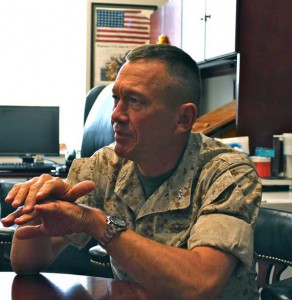
But so is the most significant force for being the absolute best that a fighter pilot can feel which is day in and day out peer pressure by those they really and truly respect, their squadron mates.
One point that has to be noted is that in the cycle of fighter designs some aircraft have were designed with a crew concept. Examples are the F-4 Phantom II at one time active in the Air Forces of 12 nations, the USN F-14, and some type/model/series (T/M/S) of the F/A-18 and the F-15E.
The two flying warriors regardless of T/M/S and designation RIO-Radar Intercept Officer for Sea Services or WSO-Weapon System Operator for USAF were 100% peer partners and the fighter could not have engaged to fight and win without solid crew mutual support in the cockpit. The use of the term Fighter Pilot in no ways ignores this partnership.
It is just that so far 5th Gen TacAir, F-22 and F-35 are single seat aircraft.
To understand the intangible of pilot performance and the future combat success of the F-35, Lightning II, one just has to listen to what the military pilots who actually are fly the aircraft are saying, all other critics are second order.
The new batch of F-35 aviators is still being led by Flag Officer aviators (0-7 and above) who have gone before. Those leaders began their fighter pilot journey in earlier generation tactical combat aircraft.
But the intangibles of squadron flying and learning transcend generations.
Until October 2015 Marine Corps pilots flying the F-35B have been second tour pilots. That is, they are pilots with flying backgrounds and with combat experience.
The VMFAT-501 Warlords, the squadron focused on initial combat training at MCAS Beaufort had their first tour “nugget” pilot coming to fly the F-35B. That first tour Naval Aviator serving as a Marine pilot is just the first of thousands that for decades to come will join the F-35 global fighter pilot world.
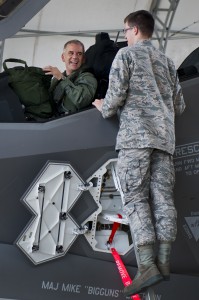
This is what Lt. General “Dog” Davis (an AV-8 pilot), the Deputy Commandant of Aviation, once the I Pad generation pilots coming into the force:
“I think it’s going to be the new generation, the newbies that are in the training command right now that are getting ready to go fly the F-35, who are going to unleash the capabilities of this jet.
They will say, ‘Hey, this is system will give me. Don’t cap me; don’t box me in.”
It can never be underestimated how important it is that the now senior aviation commanders, regardless of service or country, had to rise successfully through squadron life to arrive at the top of Wolfe’s pyramid of excellence in their specific combat aircraft whether they flew F-4s, AV-8s, F-14s, F-15s, F-16s or F/A-18s.
It is a brutal fact of winning or losing an air campaign that past combat experience in the air count can count strongly regardless of fighter flown at the time.
The current new cohort of F-35 Squadron pilots, at all ranks, are building on a powerful legacy of air combat forces that have been forged in a life and death cauldron of two magnificent victories.
A perfect example of the generational transition of a tested pilot raising in rank to senior general officer command who is now leading his fighter pilots into the future is the Commanding General of the USAF Warfare Center, Nellis AFB 5, Major General Silveria, who graduated from USAFA ’85 during the Cold War, who now is a qualified F-35 pilot.
From his USAF official bio: General Silveria has flown combat sorties over the Balkans and Iraq and served as Vice Commander at Bagram Air Base in Afghanistan. He is a command pilot with more than 3,800 hours in the T-37, T-38, F-15C/E, HH-60 and F-35A aircraft.
General Silveria’s command saw on January 15th, 2016, the fifth F-35A landing at Nellis, and was the first F-35A fully configured for the planned initial operational capability for the USAF next year.
This specific aircraft addition to the weapons school marked a crucial moment in shaping the way ahead, as General Silveria comments:
“Having this aircraft at Nellis represents the beginning in the operational tests in earnest for the F-35 program and represents the beginning of tactical development of the F-35 at the weapons school.
We have some F-35s here in earlier configurations, but the plane, which landed today, is the plane we will go operational with.
We need this aircraft and this configuration to shape the tactics in taking the aircraft into operation in 2016.
This is the first of many as more F35s will flow into Nellis this year and next.
The pilot who has landed today is the first pilot in the 57th Wing in Nellis, which will be writing the syllabus for the Weapons School with the first pilots graduating from that program in 2018.”
The Past as Prologue
These now senior combat pilot commanders, albeit much junior at the time, achieved two magnificent victories; winning the air rivalry against the USSR in the Cold War and achieving an historic allied success in the magnificent air campaign of Desert Storm.
The lesson for the air power rivalry between the US and USSR is rather straightforward: the technology had to be available but it also had to be successful understood and employed.
A historical take away from the cold/hot war air battles is that in the air-to-air mission a country that equips its fighters with airborne radar and sensors allows more autonomous action and actually favors tactical simplicity and operational autonomy—even though the equipment becomes more complex.
In air-to-ground, airborne simplicity indicators are usually smaller formations and allowance to maneuver independently into weapon launch envelopes primarily in a weapons-free environment. Embedding technology into the weapon itself –bombs and rocket-fired weapons– has also made a revolutionary difference.
In air combat a nation must always assume a reactive enemy can develop the necessary technology to try and mitigate any advantages. With the worldwide proliferation of weapons even a second or third world nation might have state-of-the art systems.
The air war over the skies of Vietnam and in the Middle East in the Yom Kippur War was between two aviation technology peer competitors because of USSR TacAir type/model/series (T/M/S) support to aerial advisories.
The lesson on the Cold War US-USSR rivalry is that air combat leaders must be able to adjust during the course of an air battle or war by changing strategy and tactics, to achieve exploitation of the enemy’s mistakes or weakness.
Aircrews must be adaptable enough to follow changing commands from leadership and also, on their own initiative, to change tactics to achieve local surprise and exploitation. Like the quote in Animal House: “knowledge is good.” In the cockpit, it can be a lifesaver and aid in mission accomplished.
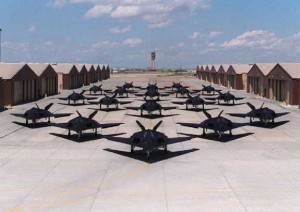
An air-to-air engagement totally slaved to a ground controlled radar attack, the USSR model was a colossal failure and deadly to a lot of pilots locked into such a system.
A bottom-up approach with evolving aircraft system capabilities in a competitive airframe makes for adaptive, creative aircrews that will have a large repertoire of tactical moves and a better chance of getting inside an opponent’s Observe, Orient, Decide and Act (OODA) loop.
This is true for both air-to-air and air-to-ground combat missions.
As the history of war in the air shows it was a constantly evolving process of human factors integrated into technology. The Cold War ended well for humanity and a lot of courageous pilots, bold leaders, and smart technologists deserve a lot of credit for this great victory.
The US would be wise to remember the lessons learned and along the way the loss of very good men in the air who paid in their blood for America and our allies today to have the best technology available flown by best combat aviators a country can produce.
And the challenge will be to shape evolving concepts of operations to take advantage of the 5th generation aircraft and the associated new tools of combat.
With respect to the Desert Storm Air Campaign, a US Air Force fighter pilot at the rank of Squadron Commanding Officer (0-5 LTC) succeeded in refocusing the combat potential of airpower that carries forward to this day:
In a Breaking Defense piece published on January 20, 2016, Lt. General Deptula (F-15 Fighter Pilot) looked back at Desert Storm and its applied its lessons to the current air operation in the Middle East:
When the clock hit 0300 on January 17, 2016 in Baghdad, it marked the 25th anniversary of the start of Operation Desert Storm, a turning point in the conduct of modern warfare.
Desert Storm changed major conflict in five principal ways:
- It set expectations for low casualties–on both sides of the conflict;
- It presaged precisionin the application of force;
- It introduced the conduct of a joint air campaign that integrated all service air operations under the functional command of an airman;
- It established desired effects as the proper focus of strategy and of the ensuing planning and conduct of operations;
- And it relied on airpowerfor the first time ever as the principal force in the strategy and execution of a war.
Ground forces acting as a blocking force while airpower destroyed enemy forces from above during the 43 days of Desert Storm airpower. Only in the last four days of the conflict were ground forces committed to combat with the goal of evicting Iraq’s occupying forces from Kuwait.
Desert Storm’s opening-night attacks signaled a radical departure in the conduct of war. This was not a linear rollback campaign: It was a strategic campaign using focused attacks against key nodes in a concurrent, simultaneous fashion. More than 150 discrete targets—in addition to regular Iraqi army forces and surface-to-air missile sites—made up the master attack plan for the first 24 hours. The war began with more targets attacked in one day than the total number of targets hit by all of the Eighth Air Force in the years 1942 and 1943 combined.
That was more separate targets attacked in less time than ever before in history.
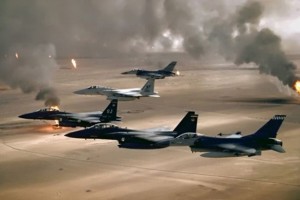
The first two challenges required technological solutions that simply had not matured until the late 1980s.
Those two solutions were stealth and precision.
To provide insight into the importance of those two developments, during the first 24 hours of Desert Storm, stealth, precision and effects-based planning allowed the use of just 36 stealthy aircraft armed with precision-guided munitions against more separate targets than the entire non-stealthy/non-precision air and missile force launched from the entire complement of six aircraft carriers and all other ships in the theater combined.
That stealthy F-117 force flew fewer than 2 percent of the campaign’s combat sorties, yet struck more than 40 percent of all Iraqi fixed targets.
The combat leverage that stealth made possible in the Gulf War can be further seen in the case of the first non-stealthy attack on one target with three aim points on Shaiba airfield in the Basrah area of southeast Iraq.
It took four Navy A-6s dropping bombs, four Saudi Tornado bomb droppers: five Marine Corps A-6Bs for jamming acquisition radars, four Air Force F-4Gs taking out one type of surface-to-air missile system, 17 Navy F/A-18s taking out another SAM system, four additional F/A-18s as escort, and three drones to force the enemy radars to radiate. That made for a total of 41 aircraft, with just eight of them dropping bombs on three aimpoints connected with just one target.
At roughly the same time, the US had 20 F-117s airborne, with all 20 dropping bombs on 38 aim points associated with 28 separate targets. So less than half the number of aircraft hit more than twelve times the number of aim points.
Enter Today’s Squadron Pilot
Among the most intangible qualities of a combat force are those cultural factors that influence its basic fighting capabilities. These qualities can be of paramount importance.
To take what is the most sensational example, consider the Kamikaze pilot. No mere quantitate assessment of the Japanese tactical aviation forces of the Second World War could have accounted for Kamikazes. Only an assessment of cultural characteristics could have keyed analysts to the possibility. In retrospect, we can understand that the Japanese belief in the divinity of their empire and the cultural abhorrence of shame could allow for creating pilots sufficiently motivated to embrace suicidal missions.
The example of Kamikazes is not representative of this discussion, but only illustrates those cultural factors, despite their intangibility, must somehow be reckoned with.
One of the essential elements of creating a successful combat fighter pilot is simply motivation often expressed as dedication, heart, will, ambition or competitiveness. It captures the qualities of a fighting force that makes its warriors enthusiastic rather than lackadaisical or dispirited.
Of course inside the ever advancing complexities of 21st Century 5th Gen aircraft technology and the resulting con-ops there is a factor of also recognizing a fighter pilots a technological capability match which is the capacity of a pilot to understand and operate the rather sophisticated technology of their state-of-the-art aircraft.
So the challenge for any serious nation that invests in an Air Force is to select, train and employ the best fighter pilot they possibly can. If Fighter Pilots could be engineered like engineering ever advancing physical technology it would have already been done. But that is not the case so an approximation of pilot effectiveness can be made on basis of training until real combat becomes the final and ultimate judge.
Techniques for transforming fledging students into proficient combat pilots have evolved through the years as the result of much research and development. Although training techniques constitute a necessary, although not completely sufficient, component, they are actually becoming increasingly important as weapons and warfare become more complex.
There are, of course contributors to pilot proficiency other than training techniques.
The inborn abilities some pilots seem to possess play a huge part. But there is little reason to believe individuals with these natural abilities exists disproportionately among nations.
In fact the actual combat history of kill ratios show that many nations can produce both Aces (5 kills) and even super-aces with many many aerial victories. What clearly does play a role and can differ significantly from one nation to another are the cultural and social qualities that give air-crews the motivation to fight and the basic capacity to successfully use the technology in the aircraft and weapons they fight with.
“Flying should be an inherently dangerous business to weed out the weak sticks,” is a Marine pilot’s saying. One would hope that there could be less dramatic and much more cost-effective method for developing aviators.
The Goal of Combat Fighter Training: To Win in Combat from SldInfo.com on Vimeo.
But a brutal fact of combat is to that be a good combat pilot one must fly the aircraft well right up to the edge of it’s flight envelope.
It is in the early training toward their “Wings” all the worlds air forces must train their pilots to simply fly successfully so at least they will not crash their aircraft frequently.
Beyond safely flying around the base flag pole, the real focus of creating a successful Squadron Fighter Pilot rests in the dynamics of combat training and then subsequent proficiency training as the individual rotates in and out of a squadron.
The list is not complete but combat training for the first tour “nugget” has drivers such as a Training and Readiness syllabus (T&R Manual). Different Air Forces have different names but it is a check list of “hops” increasing in complexity that a newly arrived aviator must successfully accomplish to advice in sequence in order to become fully combat qualified.
A key intangible, that should never be overlooked, is the source of instructors during this combat training cycle, along with measurable indices such as live firing/weapons release, and simulator training Combat training is a progression of building block sorties of more and more demanding tactical and weapon training flights that will ultimately rise to the level to operate their fighter against the highest threat environment in the world.
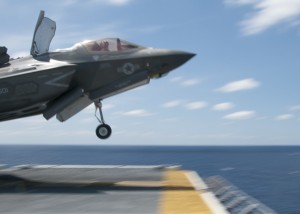
Once an aviator in any nation has achieved the distinction that the leadership thinks they are ready to go to war, they either enter a combat theater, or must continue in demanding proficiency training. Also after their first tour because they may have been cycled out of flying for another assignment, a fighter pilot eventually returning to the cockpit must begin proficiency training all over again.
Elements of proficiency training can include actual combat: which is everything.
It is important to recognize that US and some Allied airpower forces, have had some previous combat flying after Desert Storm, such as over the Balkan sky and in Iraq called Northern Watch and Desert Fox. US airpower has been engaged in constant combat since soon after 9/11.
Like the legacy of WWII to the Cold War and Deseret Storm this demanding combat flying, thankfully with far fewer causalities, is a huge factor experienced by this generation as they advance in rank to lead the next generation of Squadron Pilots.
Time in the air, and specifically time in type doing tactical flying is of utmost importance.
Without actual combat intensive training can include advanced exercises such as Red Flag and also very specific focused training such as going through the Top Gun program. Such programs greatly influence not only proficient tactical flying to edge of the envelope, but also create a critical dynamic fed-back loop of ever improving combat tactics to fight and win.
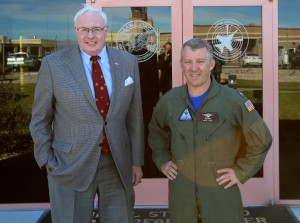
This is very evident a Fallon because, a perfect example of real time dynamic development of combat con-ops was described by Rear Admiral Scott Conn, (F/A-18 Fighter Pilot) Commander Naval Strike and Air Warfare Center:
“Question: We found it interesting that your strike integration training involves as well regular dialogue with the deployed carriers and apparently you work in support of the deployed fleet as well in shaping TTPs, which they might need in ongoing operations. Could you speak to that process?
Admiral Conn: NSAWC innovates in peacetime while providing the reach back support to adapt in war. We are in regular communication with the deployed carriers, and provide technical and tactical reach back support to address observed shortfalls in combat to existing TTPs.
An historical example of how NSAWC provided reach back support to the forward deployed warfighter was in the early stages of Afghanistan operations. Ground commanders needed aircraft to strafe at night. To do this strafing mission at night, aircrew needed to put an airplane below mountaintops, perhaps in a valley, provide bullets precisely and then pull off target, and not fly into the terrain.
When NSAWC got this request, in a matter of weeks because it wasn’t overnight, a couple weeks, we came up with the tactics, techniques, and procedures for the fleet to execute that mission. We then folded those TTPs into our training for follow on deployers.
And the connectivity we have with the fleet through modern communications allows for an ongoing combat learning process between Fallon and the fleet and this flow of information is central to the process of training in the 21st century.”
The Squadron Pilots Get Their Hands On The F-35
Before the first F-35 Lightning II took off, American and allied defense industries were put to the test: build the very best. They have met that challenge.
“Scientists dream about doing great things. Engineers do them” from the James Michener book Space. The quote originated from one of the legendary American Aeronautical Engineers, Jack Runckel who began with NACA before WWII and finished with NASA. As many history books state: During World War II, NACA was described as “The Force Behind Our Air Supremacy.”
Just like the aviators who will fly the F-35 who are well trained and the top of the famous Tom Wolfe’s “pyramid” in his book The Right Stuff, there is a team of engineers – American and Allied — in the defense industry and at the U.S. world famous test centers such as Pax and Edwards, who are equally dedicated and at the top of their profession in giving the warriors the best possible weapon system.
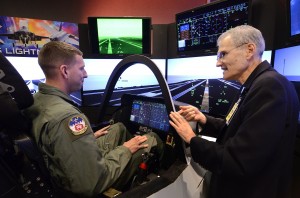
Many who have never made the effort to engage, understand and recognize the US envy of the world defense industry’s remarkable success often target the very honorable and dedicated workforce with extremely negative comments.
American, USAF, USN and USMC and Allied F-35 test pilots day in a day unheralded at personal risk to themselves and always the possibly of bring tragedy to their loved ones, have mostly been ignored while still leaving critics in their jet wash.
For example, it was very telling that only three media outlets were present at Navy Pax when the Italian Test Pilot “Ninja” a former Tornado pilot with only 50 hours in type made his record setting flight across the North Atlantic in winter flying an F-35 manufactured in a brand new facility in Italy with only 15 hours on the airframe.
Every generation of test pilots flying the latest T/M/S fighter addition to their service at both Patuxent River Naval Air Station and the USAF Test Center at Edwards AFB have the most fundamental question always asked by their leaders— How to hold them back?
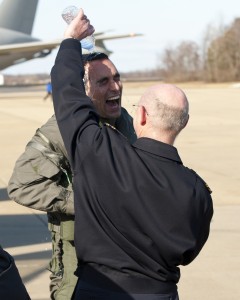
As the very first F-35s rolled off the factory floor and entered the military testing world, it is critical to note that the pilots testing the F-35 to the edge of the envelope were Squadron Pilots first.
From Chuck Yeager’s great success as a fighter pilot in WWII (a double ace, 11.5 kills including a German jet) to his breaking the sound barrier, to the Mercury 7 Astronauts, three Navy Pilots, three AF and the US Marine John Glenn who were first American’s in space, to today’s test pilots it must be noted that they all began in an operational Squadron.
Test pilots being squadron pilot warriors first is not unique to the American flying services as the collection of other nations test pilots fully integrated into the F-35 flight and operational test regime proves.
One of the most impressive and again little noticed fact of the F-35 progression toward Initial Operational Capability (IOC) with US and Allied flying forces is that they are a team of peers around the globe. Never before has such a wide raging state-of-the-art test/IOC effort been attempted and now has been proven successful.
The F-35 is essentially a combat aviation club that is only limited by the imagination and skill of those who will fight the aircraft in the air.
As the F-35 moves into squadrons in different nations with different potential combat challenges around the globe all fighter pilots share a unity of purpose. Using the trite cliché “global commons” does not come close to what is occurring.
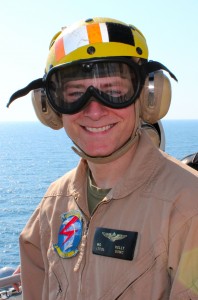
It is much more co-equal partners in 5th gen combat sharing in which the quest of being part of a team of victorious killers is much more the “combat commons” that all aspire to join.
Pax river test pilots in a 2010 interview of USMC Test Pilots “Squirt” and “Tinman” to a 2016 interview with US Navy Test Pilots “Dutch” and “Tonto” capture the evolving maturity of the test cycle for fleet wide US Sea Service IOC Squadrons.
“Squirt”, test pilot of the year shortly after our interview and a former F/A-18 Squadron pilot was deeply involved in the pilot/helmet/fusion cockpit interface, which is a critical component of the XXIst Century Man-Machine Revolution. With the very real computer revolution moving with light speed into the 21st Century there is now a powerful design dynamic at work —the man-machine interface.
With the very real capability of three dimensional sensing and being able to distribute information to other arfighters, airborne and on the ground or at sea the relationship of the individual pilot to knowledge of the bigger air battle is truly revolutionary.
“Tinman” a former USMC AV-8 pilot who flew in the at sea trials marveled how easy the F-35 was to fly and put the nose tire in a one square box on the pitching deck of the USS Wasp.
Consequently one of the most underappreciated aspects about the test program is how the concurrent learning among the various test centers provides enhanced confidence and accelerates testing with all T/M/S of this new aircraft.
The cross learning from the USMC F-35B, the service’s first T/M/S to achieve IOC, to the USAF F-35A to the USN F-35C model — with the preparation of the first RAF F-35B squadron — has meant that the USN can operate its Cs more rapidly and with more confidence and capability than in a traditional single-model aircraft test program.
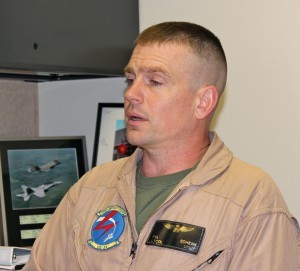
This fact was brought out five years later in early 2016, at Pax when “Dutch” a very accomplished Navy fighter pilot with over 600 cats and traps in the F/A-18 stressed how stable the F-35 will fly around the boat.
During the Vietnam War, there were tests done of carrier pilots’ heart rates which we actually higher when landing on a carrier than when being shot at over Hanoi:
“The flying qualities are excellent and the machine systems built into the plane significantly enhance the ease of landing and taking off from the carrier.
Basically with the F-35 you get your mission cross-check time back.
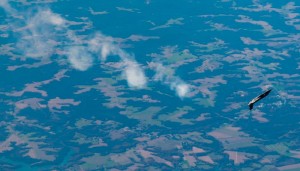
Normally once you start the approach your scan is solely meatball, line up, and angle of attack. Your mission cross-check time behind the ship is zero because you’re just doing that scan.
With the F-35 and its enhanced flight controls and superb handling, the aircraft doesn’t deviate much from the desired flight path, which greatly eases the workload on the ball and frees up your scan. —It almost makes flying the ball a relaxing task!”
The fact that the Navy Test Pilots will rotate back into combat was not lost when Tonto made a seminal combat point about the generational shift from F/A-18 Hornets to the USN F-35C:
“How do you see the F-35 affecting tactical training?
Answer: With the current air wing (i.e, with the Super Hornet and Hornet as the tip of the spear), we are wringing out our tactics for a tactical advantage, which is also, at the same time, at the edge of the envelope for survival.
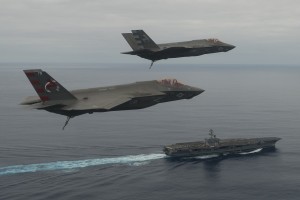
We are spending a lot of time making sure that we have the right tactics and the mastery of those tactics by pilots to survive and succeed.—It is about keeping a level of competence and capability where you’re not going to die.
There are points where you have a twenty second window.—You miss that window and you might be blown up!
When you’re traveling at those speeds, we are talking really only a couple of seconds that you have. And, if you’re not performing tactics exactly as they’re prescribed, you put yourself in a kill zone.
With the F-35, we are jumping a generation in tactics and now looking at the expanded battlespace where we can expand our impact and effect. You need to take a generational leap so we are the ones not playing catch up with our adversaries.”
While test pilots are wringing out the F-35 and ignoring critics, senior officers are constantly challenged to fly top cover against know-nothing second and third order derivative critics whose only contributions are creating crossed referenced ignorant public articles written by cubical commandoes whose only real skill is creating google search interlocking fields of fire.
General Mike Hostage (F-15 and F-16 Fighter Pilot) the past commander of the US Air Combat Command (ACC) made the effort to qualify in the 5th Gen F-22 Raptor could put a very credible marker down for the public debate in our Breaking Defense article:
“I was fortunate to fly the airplane (F-22); I learned what I didn’t know. I was writing war plans in my previous job as a three star using the F-22s in a manner that was not going to get the most out of them that I could’ve because I didn’t truly understand the radical difference that the fifth gen could bring.

People focus on stealth as the determining factor or delineator of the fifth generation. It isn’t; it’s fusion. Fusion is what makes that platform so fundamentally different than anything else. And that’s why if anybody tries to tell you hey, I got a 4.5 airplane, a 4.8 airplane, don’t believe them. All that they’re talking about is RCS (Radar Cross Section).
Fusion is the fundamental delineator. And you’re not going to put fusion into a fourth gen airplane because their avionic suites are not set up to be a fused platform. And fusion changes how you use the platform.”
Picking up the viewpoint from the Navy’s Director of Air Warfare, Rear Admiral Michael Manazir USNA ’81 another cold-then hot war- fighter pilot flying F-14s then the F/A-18 one can see the unity of vision and purpose driven by the introduction of the F-35, while also recognizing the specific challenges that each of the US combat aviation services face.
“It is about how the sea services overall were being transformed by the ability to work more effectively with the other US services and other nations. Too often in defense discussions, focus is on a particular platform — a ship, a plane, a vehicle — and not on how new platforms work with what we already have to enhance the force as a whole.
What the Ford-class, the Joint Strike Fighter, and future unmanned platforms bring is the ability to pull the information in and be an epicenter of an enlarged and extended reach for the joint and coalition force.
With its ability to push data back to the ships and across the international coalition of F-35 operating nations, the F-35 is more than just a new strike fighter: It is part of fundamental change in the way the sea services operate across an extended, integrated battlespace.”
In building a body of knowledge at the pilot level, Marine leadership joined forces with the visionary Secretary of the Air Force Mike Wynne and COS Buzz Mosely, who in partnership with AF Chief General Buzz Moseley (F-15 Fighter Pilot) created a special flying billet in an F-22 Raptor Squadron for a Marine Fighter Pilot Lt. Col. Chip Burke.
The Honorable Mike Wynne, Secretary of the USAF together with General Buzz Moseley Chief of Staff working with the full visionary support of LtGen George Troutman, Deputy Chief of Staff Aviation, USMC to put a non-USAF pilot into an F-22 to jump start USAF thinking and to gain better joint force understanding the transition.
Lt. Col. Berke was a key player in that effort. A USMC Squadron Fighter Pilot, he went to Nellis to train on the F-22. Lt. Col. Berke was then the F-35B squadron commander for the USMC at the 33rd FW Eglin AFB, and is the only F-22 and F-35 pilot in existence. His background is truly unique. Lt. Col. Burke was also an F/A-18 Carrier Qualified Fighter Pilot, a Top Gun F-16 instructor pilot and also served on the ground in combat with the US Army.
Secretary Wynne and Chip Burke had a seminal meeting and discussion at the F-35 initial “school house” Eglin AFB where the first F-35, USMC, USAF and USN Squadron pilots were being transitioned to the Lightning II.
As Wynne explained:
“Finding the enemy, fixing the enemy, and destroying him is a fleet task, not the individual aircraft or squadron. What’s going to happen now is we’re going to go up there and find the enemy, and assign it away.
This affects training because we now need to train pilots to think from the standpoint of command and control so the training approach would need to modified as the training became more advanced.
How do you begin to start the process so that when they get to advanced pilot training that they really understand that one of the things that they’re going to have to learn is this core syllabus is going to take them into a command-and-control ops, rather than that of the traditional fighter pilot.”
And that is exactly what is happening at the Marine Aviation Weapons and Tactics Squadron -One, Yuma, with the USAF Weapons Schools and home to Red Flag at Nellis AFB and the Naval Strike and Air Warfare Center, NAS Fallon.
As previously mentioned, a key intangible that should never be underestimated for combat success, is the source of instructors during a squadron pilots combat training cycle.
These three different services graduate schools of studying and perfecting combat flying; USMC- MAWTS, USAF -Weapons School, and the Navy’s-NSAWC, are the absolute top of the Fighter Pilot pyramid in both turning out the best combat instructors while also focusing on a flying curriculum to embed selected Squadron Pilots who undergo their post-graduate train back into their Squadrons in order to instill in all their mates the most current tactical thinking on how to fly, fight and win any air battle in any threat conditions in any part of the globe.
In the summer of 2015 the USMC declared VMFA-121 ‘The Green Knights “ IOC with the F-35B and thus that fighter squadron became the first operational F-35 combat squadron in the world. Commandant of the Marines, General Joe Dunford, who is now Chairman of the Joint Chiefs of Staff announced IOC :
“VMFA-121 has ten aircraft in the Block 2B configuration with the requisite performance envelope and weapons clearances, to include the training, sustainment capabilities, and infrastructure to deploy to an austere site or a ship. It is capable of conducting close air support, offensive and defensive counter air, air interdiction, assault support escort and armed reconnaissance as part of a Marine Air Ground Task Force, or in support of the Joint Force.”
Interviewing Lt. Col. Gillette the first Commanding Officer of 121 while he was transiting to F-35 by standing up the Marine F-35 training squadron, VMFAT-501, Warlords, at Eglin AFB, he stressed the importance of combat experience to shaping the approach, which the jet will follow as it, is integrated into USMC operations.
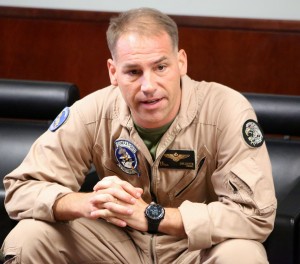
“The USMC with its experiences in Libya, Iraq and Afghanistan certainly has logged significant understanding of how combat jets are used to support the MAGTF and ground forces overall.
The warriors are bringing the war to the airplane. The airplane is not going to war for the USMC by itself. In other words, operational experience precedes the F-35 B and it is being melded into this new piece of equipment.
This experience of the past decade is being taken forward into the next and will be an important part of shaping the operational approach for the first decade of the F-35B and its experience with the USMC.
The ability of the airplane to ingest information from all different sources, fuse it, will now level the playing field to some extent between the seasoned flight lead, who is doing the communication with the guy on the ground, and the rest of the squadron.
The plane will immediately transmit all the situational awareness built into the plane and provide it to the least experienced member of the flight squadron. And that will happen just like that.”
The key to the future, as demonstrated at Yuma is to put the F-35B in the hands of the operators.
The pilots of VMFA-121 are working very closely with USAF pilots as the Air Force prepares for its IOC in 2016, fellow Naval Aviators in the USN are also clearly involved
As Major Summa, the Executive Officer of VMFA-121 at Yuma, who is now LtCol Summa CO of VMFAT-501 at MCAS Beaufort SC, put his Squadron/MAWTS learning in a joint service perspective;
“Working with the other service pilots provides an important window on where we want to go with the concepts of operations of the aircraft. We have different backgrounds, Harrier, F-18s, F-16s, F-22s, and F-15s, but we understand that given the commonality of the aircraft these different backgrounds suggest common ways ahead. We are all able to contribute to the way ahead for a common aircraft.
And already some very different ways of operating are suggesting themselves.
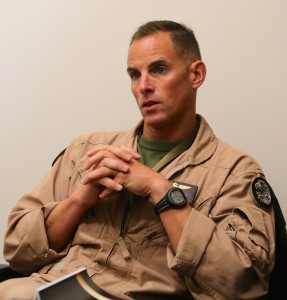
Historically, there is a one to one relationship between combat aircraft and mission support aircraft in doing certain types of initial insertion missions.
With the F-35 and its combination of stealth and fused combat missions we can reduce dramatically the need for mission support aircraft in initial operations. For example, a non-kinetic electronic warfare option is one button push away.”
The co-location of VFMA-121 with MAWTS-1 is an important part of the introduction of the aircraft.
While VFMA-121 is now operational, MAWTS-1 is responsible for the tactics and training for USMC aviation. F-35, MAWTS instructors are flying with VFMA-121 to shape evolving concepts of how to standardize fleet operations for the new aircraft.
As a former CO of MAWTS-1 then the Commanding General of 2nd Marine Air Wing, Major General Robert Hedelund put it: “VFMA-121 will figure out how to kill the enemy more effectively and MAWTS will standardize the approach.”
And soon very soon Allied Air Forces, along with more USMC, USAF and USN F-35 Fighter Squadrons will be standing up and reaching IOC. All F-35 Fighter Pilots will be part of a global combat enterprise, unified but diverse, in full partnership such as the world has never seen before.
AND it all begins with trained squadron pilots.
Editor’s Note: A special thanks goes to Ed Timperlake in this and many other pieces for bringing his squadron experience and flight experience as a Naval Aviator who is both carrier qualified and also his Phase 1, SATS LSO (short airfield for tactical support landing signals officer) experience into the interviews, and creating a ready room experience, which highlights the significant impact which the squadron pilots play in airpower innovation. Ed was the CO of VMFA-321, a USMC Fighter Squadron as well.
For a PDF version of the article, see the following:

